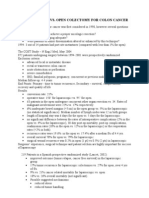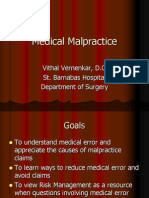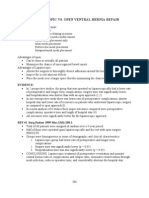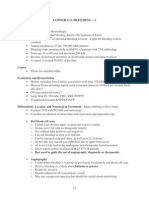Hernias, Mesh Repairs and Infection
Hernias, Mesh Repairs and Infection
Uploaded by
Louis FortunatoCopyright:
Available Formats
Hernias, Mesh Repairs and Infection
Hernias, Mesh Repairs and Infection
Uploaded by
Louis FortunatoCopyright
Available Formats
Share this document
Did you find this document useful?
Is this content inappropriate?
Copyright:
Available Formats
Hernias, Mesh Repairs and Infection
Hernias, Mesh Repairs and Infection
Uploaded by
Louis FortunatoCopyright:
Available Formats
HERNIAS, MESH REPAIRS AND INFECTIONS
Background Hernia repairs are considered a routine procedure in the United States, but the field of hernia repair has changed dramatically in the past decade. Conventional method o interrupted sutures o Mayo technique Mesh repair o significantly reduced recurrence rate Laparoscopic mesh repair o even lower recurrence rate o lower infection rate
Mesh repairs various types of mesh o preformed polypropylene mesh plug o flat mesh rolled into a cylindrical plug o Prolene hernia system Studies on these techniques have reported very low recurrence rates ranging from 0% to 2%. Antibiotic prophylaxis usually single dose IV ampicillin and sulbactam pooled studies reported, at most, a 1 2% not statistically significant improvement with antibiotic prophylaxis Infections reported rates of infection following open mesh hernia repair range from 0 9%, but this is questionable due to an inconsistent definition of clinically relevant infection bacteria involved are typically skin flora, such as Staphlococcus aureus and Staphlococcus epidermis, or may be from anaerobic bowel flora including Bacteroides fragilis and Echerichia coli incidence of mesh infection in laparoscopic repair is demonstrably less than with open approach. This is due to: o introduction of the mesh through trocars o avoiding skin contact o mesh placement far from the trocar incision
286
Management of Mesh Repair Infection
All postoperative patients with fever, drainage, or swelling, should be evaluated for wound infection
Infection not present
Infection present
Treat with broad spectrum antibiotics empirically
Improvement?
No Improvement?
Wound should be opened, cultures obtained
Failure to improve warrants more aggressive wound exploration with packing open of wound When does mesh within infected surgical site need to be removed? Retrospective case studies suggests that mesh may be preserved in most cases following exposure and drainage of the wound
Vince Nguyen, MS 4 June 9, 2005
287
You might also like
- The Subtle Art of Not Giving a F*ck: A Counterintuitive Approach to Living a Good LifeFrom EverandThe Subtle Art of Not Giving a F*ck: A Counterintuitive Approach to Living a Good LifeRating: 4 out of 5 stars4/5 (5986)
- The Gifts of Imperfection: Let Go of Who You Think You're Supposed to Be and Embrace Who You AreFrom EverandThe Gifts of Imperfection: Let Go of Who You Think You're Supposed to Be and Embrace Who You AreRating: 4 out of 5 stars4/5 (1112)
- Never Split the Difference: Negotiating As If Your Life Depended On ItFrom EverandNever Split the Difference: Negotiating As If Your Life Depended On ItRating: 4.5 out of 5 stars4.5/5 (898)
- Hidden Figures: The American Dream and the Untold Story of the Black Women Mathematicians Who Helped Win the Space RaceFrom EverandHidden Figures: The American Dream and the Untold Story of the Black Women Mathematicians Who Helped Win the Space RaceRating: 4 out of 5 stars4/5 (932)
- Grit: The Power of Passion and PerseveranceFrom EverandGrit: The Power of Passion and PerseveranceRating: 4 out of 5 stars4/5 (619)
- Shoe Dog: A Memoir by the Creator of NikeFrom EverandShoe Dog: A Memoir by the Creator of NikeRating: 4.5 out of 5 stars4.5/5 (546)
- The Hard Thing About Hard Things: Building a Business When There Are No Easy AnswersFrom EverandThe Hard Thing About Hard Things: Building a Business When There Are No Easy AnswersRating: 4.5 out of 5 stars4.5/5 (357)
- Her Body and Other Parties: StoriesFrom EverandHer Body and Other Parties: StoriesRating: 4 out of 5 stars4/5 (831)
- Elon Musk: Tesla, SpaceX, and the Quest for a Fantastic FutureFrom EverandElon Musk: Tesla, SpaceX, and the Quest for a Fantastic FutureRating: 4.5 out of 5 stars4.5/5 (477)
- The Emperor of All Maladies: A Biography of CancerFrom EverandThe Emperor of All Maladies: A Biography of CancerRating: 4.5 out of 5 stars4.5/5 (275)
- The Little Book of Hygge: Danish Secrets to Happy LivingFrom EverandThe Little Book of Hygge: Danish Secrets to Happy LivingRating: 3.5 out of 5 stars3.5/5 (425)
- The World Is Flat 3.0: A Brief History of the Twenty-first CenturyFrom EverandThe World Is Flat 3.0: A Brief History of the Twenty-first CenturyRating: 3.5 out of 5 stars3.5/5 (2272)
- The Yellow House: A Memoir (2019 National Book Award Winner)From EverandThe Yellow House: A Memoir (2019 National Book Award Winner)Rating: 4 out of 5 stars4/5 (99)
- The Sympathizer: A Novel (Pulitzer Prize for Fiction)From EverandThe Sympathizer: A Novel (Pulitzer Prize for Fiction)Rating: 4.5 out of 5 stars4.5/5 (125)
- Devil in the Grove: Thurgood Marshall, the Groveland Boys, and the Dawn of a New AmericaFrom EverandDevil in the Grove: Thurgood Marshall, the Groveland Boys, and the Dawn of a New AmericaRating: 4.5 out of 5 stars4.5/5 (270)
- A Heartbreaking Work Of Staggering Genius: A Memoir Based on a True StoryFrom EverandA Heartbreaking Work Of Staggering Genius: A Memoir Based on a True StoryRating: 3.5 out of 5 stars3.5/5 (232)
- Team of Rivals: The Political Genius of Abraham LincolnFrom EverandTeam of Rivals: The Political Genius of Abraham LincolnRating: 4.5 out of 5 stars4.5/5 (235)
- On Fire: The (Burning) Case for a Green New DealFrom EverandOn Fire: The (Burning) Case for a Green New DealRating: 4 out of 5 stars4/5 (75)
- The Unwinding: An Inner History of the New AmericaFrom EverandThe Unwinding: An Inner History of the New AmericaRating: 4 out of 5 stars4/5 (45)
- Brain Cancer: by Cara KlingamanDocument16 pagesBrain Cancer: by Cara KlingamanLouis FortunatoNo ratings yet
- 07 PETImagingDocument61 pages07 PETImagingLouis FortunatoNo ratings yet
- Latent TBDocument24 pagesLatent TBLouis FortunatoNo ratings yet
- Biological Effects of Ionizing RadiationDocument18 pagesBiological Effects of Ionizing RadiationLouis FortunatoNo ratings yet
- Retroperitoneal SarcomaDocument2 pagesRetroperitoneal SarcomaLouis FortunatoNo ratings yet
- 10 - HIDA ScanDocument19 pages10 - HIDA ScanLouis FortunatoNo ratings yet
- Laparoscopic vs. Open Colectomy For Colon CancerDocument4 pagesLaparoscopic vs. Open Colectomy For Colon CancerLouis FortunatoNo ratings yet
- Renal Cell CarcinomaDocument9 pagesRenal Cell CarcinomaboianlinaNo ratings yet
- Medical Malpractice: Vithal Vernenkar, D.O St. Barnabas Hospital Department of SurgeryDocument15 pagesMedical Malpractice: Vithal Vernenkar, D.O St. Barnabas Hospital Department of SurgeryLouis FortunatoNo ratings yet
- Laparoscopic Vs Open Ventral Hernia RepairDocument4 pagesLaparoscopic Vs Open Ventral Hernia RepairLouis FortunatoNo ratings yet
- Multiple Myeloma PresentationDocument15 pagesMultiple Myeloma PresentationLouis FortunatoNo ratings yet
- Hernias, Mesh Repairs and InfectionDocument2 pagesHernias, Mesh Repairs and InfectionLouis FortunatoNo ratings yet
- Lower GI Bleeding - 1Document6 pagesLower GI Bleeding - 1Louis FortunatoNo ratings yet
- Medical Malpractice: Vithal Vernenkar, D.O St. Barnabas Hospital Department of SurgeryDocument15 pagesMedical Malpractice: Vithal Vernenkar, D.O St. Barnabas Hospital Department of SurgeryLouis FortunatoNo ratings yet
- Liver BiopsyDocument4 pagesLiver BiopsyLouis Fortunato100% (1)
- GIST of The StomachDocument3 pagesGIST of The StomachLouis FortunatoNo ratings yet
- Oral Cancer PresentationDocument14 pagesOral Cancer PresentationLouis FortunatoNo ratings yet
- Cricothyroidotomy 1Document42 pagesCricothyroidotomy 1Louis FortunatoNo ratings yet

























































